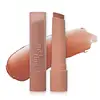What's inside
What's inside
 Key Ingredients
Key Ingredients

 Benefits
Benefits

 Concerns
Concerns

 Ingredients Side-by-side
Ingredients Side-by-side

Diisostearyl Malate
EmollientPolybutene
Polyglyceryl-2 Triisostearate
EmulsifyingBis-Diglyceryl Polyacyladipate-2
EmollientCaprylic/Capric Triglyceride
MaskingMicrocrystalline Wax
Emulsion StabilisingSynthetic Wax
AbrasiveCI 77891
Cosmetic ColorantStearalkonium Hectorite
Gel FormingParaffin
PerfumingCI 77491
Cosmetic ColorantPropylene Carbonate
SolventParfum
MaskingCaprylyl Glycol
EmollientCI 77499
Cosmetic ColorantButyrospermum Parkii Butter
Skin ConditioningEthylene/Propylene Copolymer
AbrasiveEthylhexylglycerin
Skin ConditioningCI 15850
Cosmetic ColorantTrehalose
HumectantWater
Skin ConditioningButylene Glycol
HumectantZingiber Officinale Root Extract
MaskingDiisostearyl Malate, Polybutene, Polyglyceryl-2 Triisostearate, Bis-Diglyceryl Polyacyladipate-2, Caprylic/Capric Triglyceride, Microcrystalline Wax, Synthetic Wax, CI 77891, Stearalkonium Hectorite, Paraffin, CI 77491, Propylene Carbonate, Parfum, Caprylyl Glycol, CI 77499, Butyrospermum Parkii Butter, Ethylene/Propylene Copolymer, Ethylhexylglycerin, CI 15850, Trehalose, Water, Butylene Glycol, Zingiber Officinale Root Extract
Polyisobutene
Phytosteryl/Isostearyl/Cetyl/Stearyl/Behenyl Dimer Dilinoleate
Skin ConditioningOctyldodecyl Neopentanoate
EmollientDiisostearyl Malate
EmollientPentaerythrityl Tetraisostearate
EmollientPhytosteryl/Octyldodecyl Lauroyl Glutamate
Skin ConditioningPentaerythrityl Tetraethylhexanoate
EmollientSynthetic Wax
AbrasiveParaffin
PerfumingMicrocrystalline Wax
Emulsion StabilisingCamellia Japonica Seed Oil
EmollientAstrocaryum Murumuru Seed Butter
EmollientEucalyptus Globulus Leaf Oil
PerfumingPolyhydroxystearic Acid
EmulsifyingEthylhexyl Palmitate
EmollientLecithin
EmollientIsostearic Acid
CleansingIsopropyl Palmitate
EmollientLimonene
PerfumingCI 45380
Cosmetic ColorantPolyglyceryl-3 Polyricinoleate
EmulsifyingPolyglyceryl-2 Triisostearate
EmulsifyingCI 45410
Cosmetic ColorantCI 77891
Cosmetic ColorantCI 15985
Cosmetic ColorantPolyglyceryl-2 Diisostearate
EmulsifyingGlycerin
HumectantTocopherol
AntioxidantCeramide NP
Skin ConditioningPhytosphingosine
Skin ConditioningHyaluronic Acid
HumectantHydrogenated Lecithin
EmulsifyingPolyisobutene, Phytosteryl/Isostearyl/Cetyl/Stearyl/Behenyl Dimer Dilinoleate, Octyldodecyl Neopentanoate, Diisostearyl Malate, Pentaerythrityl Tetraisostearate, Phytosteryl/Octyldodecyl Lauroyl Glutamate, Pentaerythrityl Tetraethylhexanoate, Synthetic Wax, Paraffin, Microcrystalline Wax, Camellia Japonica Seed Oil, Astrocaryum Murumuru Seed Butter, Eucalyptus Globulus Leaf Oil, Polyhydroxystearic Acid, Ethylhexyl Palmitate, Lecithin, Isostearic Acid, Isopropyl Palmitate, Limonene, CI 45380, Polyglyceryl-3 Polyricinoleate, Polyglyceryl-2 Triisostearate, CI 45410, CI 77891, CI 15985, Polyglyceryl-2 Diisostearate, Glycerin, Tocopherol, Ceramide NP, Phytosphingosine, Hyaluronic Acid, Hydrogenated Lecithin
 Reviews
Reviews

Ingredients Explained
These ingredients are found in both products.
Ingredients higher up in an ingredient list are typically present in a larger amount.
Ci 77891 is a white pigment from Titanium dioxide. It is naturally found in minerals such as rutile and ilmenite.
It's main function is to add a white color to cosmetics. It can also be mixed with other colors to create different shades.
Ci 77891 is commonly found in sunscreens due to its ability to block UV rays.
Learn more about CI 77891Diisostearyl Malate is an emollient and most often used in lip products. It comes from isostearyl alcohol, a fatty acid, and malic acid, an AHA.
As an emollient, Diisostearyl Malate helps create a thin film on your skin to trap moisture in. This helps keep your skin soft and smooth.
Microcrystalline Wax is created by de-oiling petroleum. It is highly refined and purified before being added to cosmetics.
Microcrystalline Wax is used to enhance the texture and create even consistency. It helps stabilize a product by preventing ingredients from separating.
Paraffin is a solid created from petroleum. The term 'paraffin' can also refer to either
petroleum jelly or mineral oil.
It has natural occlusive properties which can worsen oily skin. Due to its petrolatum base, this ingredient is not fungal-acne safe.
This ingredient is a form of glycerin with emulsifying and emollient properties.
As an emulsifier, this ingredient helps keep products together while adding a thick texture. The manufacturer states this ingredient has emollient properties. Emollients help keep the skin hydrated by trapping moisture in.
Polyglyceryl-2 Triisostearate is created by reacting diglycerin and isostearic acid. Due to the isostearic acid base, it may not be safe for Malassezia or fungal acne.
Learn more about Polyglyceryl-2 TriisostearateSynthetic Wax is created from fossil fuels such as natural gas. It is used to enhance texture, adjust pH, and as an occlusive.
It may also be used as an abrasive ingredient to exfoliate the skin.
Synthetic Wax may not be fungal acne safe.
Learn more about Synthetic Wax